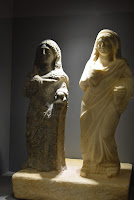(...)
We walked into a room exhibiting some of the artefacts uncovered by the 50 years of ongoing Polish excavations, which were outstandingly exquisite and beautiful to afterwards have had a brief look at some votive and funerary stele.
Bed made of wood covered with ivory plaques decorated in relief with Egyptian motifs - Late 8th century B.C.

Throne made of wood covered with ivory plaques - Salamis - Late 8th century B.C. (left). Throne with a foot stool made of wood covered with silver plating and gilded silver rivets - Late 8th century B.C. (right).

Clay head - Salamis - Late 4th century B.C (left).
Sling bullets mould fragment with scorpions in relief - 2nd century B.C. (left). Limestone Dioskouros bust - 2nd century A.D - Helenistic House (right).

Double Aphrodite - Aphrodite protectress of the marriage in white marble and Aphrodite Ourania in a mantel of stars in dark marble - 2nd and 3rd centuries A.D - Villa of Theseus.
Base of statuette of Apollo Sauroktonos - Villa of Theseus.
Funerary stele of Timokypra - Cypro-syllabic inscription - end of 6th century

Baked clay tablet with inscription in the Cypro-Minoan script - Engomi - 13th century B.C.

Votive inscription to the mother of Gods in grey marble - Greek alphabetic inscription - 2nd century B.C.

Votive inscription by fifty adolescents - Greek alphabetic inscription - 2nd century B.C.
Curse or magic spell for preventing looting of the tomb 1st and 2nd centuries B.C.
Reconstruction of a Late Bronze Age tomb (1400-1200 B.C.)

Funerary stele of a young mother - 4th century

Funerary pediment column - Helenistic period

Funerary stele of a woman - Late Roman period.
The moment we left the Museum I had to back in wonderment and take one last picture. I had really enjoyed the visit.






















No comments:
Post a Comment